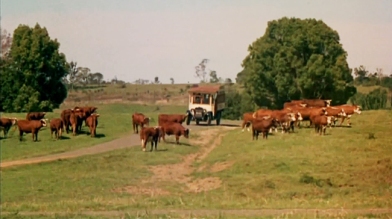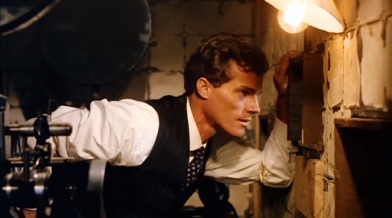
Directed by John Power, written and produced by Joan Long
Many iconic Australian actors feature in this gem of a classic Australian movie about movies. Made in 1977, The Picture Show Man is an affectionate piece of nostalgic Australiana, a vision of Australian history put to the screen during the Australian New Wave – a period characterised by the recreation of the past through a distinctive colour palette and atmospheric landscape.

The Picture Show Man portrays the struggles of a travelling silent film projectionist in rural 1920s Australia, as he and his posse travel from country town to country town, trying to compete with their rivals. John Meillon leads the cast as flamboyant Maurice Pym, John Ewart portrays the sleazy piano accompanist Freddie, and Rod Taylor is their American competitor exhibiting sound films, Palmer. The always wonderful Garry McDonald plays a small role, and Pym’s forward-thinking son Larry is played by Harold Hopkins (pictured). The outback towns of the still, sunburnt country are their Wild West; the rivalries between the competing picture show men provide just enough slapstick action and laughs to colour the muted landscape.
“War. That’s what it is! A dirty picture war.”
“If he wants war, we shall give him war.”
Interestingly, the story behind this movie involves another movie – a documentary that aired on Australian television in 1968, Joan and Martin Long’s The Pictures That Moved. It was the first in a series of three documentary films focusing on the early history of Australian filmmaking, bringing awareness of the history of early Australian film to a world that had forgotten. The son of a real travelling picture show man, Lyle Penn, saw an interview with Joan long on the television discussing her film, then sent his memoirs to her. This was the beginning of The Picture Show Man’s journey to the screen – these memoirs would serve as the basis for Long’s screenplay.
The film opens with a song. Setting the mood, this song captures the entire era in its simple rhyme and jaunty, tinny piano. Peter Best’s music and lyrics are nostalgic, even mournful, painting a vivid, yet charmingly modest portrait of the almost mythical picture show man, who rides into towns, brings them joy, takes away their cares, then drives away. And just like that, as swiftly as he came into being, the picture man disappeared into lore, forgotten when technology inevitably overtook him.
Peter Best’s opening tune, The Picture Show Man
Modernity is flirted with in the film – some characters embody it, others loathe it. The picture show man is somewhat of a resistant figure against the forces of time – the heyday of the Australian travelling showman was well and truly on its way out by the 1920s, when this film is set. In one early scene, Pym explains his aversion to using electricity:
“Electricity… is too hard on the eyes. Limelight is very soft on the eyes, you ask any audience.”
Even in his own context, the picture show man is a nostalgic figure. Celebrated and mourned, he could not survive. The loosely dissipating sands upon which the tide of progression lapped though history teaches us that these figures should not exist outside of their time; our culture teaches us that the forward momentum of time is above all else. Modernity, a force much like time itself, is superior, and all else is abandoned in its wake. It is the supreme irony of The Picture Show Man that the children of the ’20s can’t understand that this passionate, pitiful figure was once the beacon of modern Australian entertainment; a mixture of magic, tradition, technology, accessibility, and transcendence.
The picture show man is marked with woe, experience, time, and history. His mobility symbolises an old way, the squatting bushman’s way, and his son’s youthful eagerness to settle down and create a modern capitalist enterprise solidifies the importance of the chism between change, resistance to change, and the ongoing force of time and progress. He has eyes for something greater than what the old ways could provide.
“There’s not much entertainment in these little towns.”
One of my favourite moments in the film is when an Australian silent is screened to a mostly-empty audience. The loyal audience is multiracial, joyful, and sparse. Larry looks on from the projection room. We see every perspective in the sacred film viewing ritual. A child leans forward from his seat to watch the players’ antics with a bush tailed possum. It was dwindling art, but not by any fault of its own.

The film is awash with a haze of yellow Australian sun, creating an atmosphere of faded colours and a weary glow. Characters walk through gum trees, fish by the billabong, boil the billy on a campfire. It is one of the most Australian films I have ever seen, and it is about one of the most Australian forms of artistry: silent film production, presentation, and consumption. The award-winning art direction by David Copping and costume design by Judith Dorsman are both perfectly envisioned and executed to create the sublime and evocative imagery that defines The Picture Show Man.
What makes this film truly special is the unremarkable way in which it presents, with a humble truth, and a refreshing accuracy, the lively, character-filled audiences of Australian silent films. Winks, hat-tips, side-eyes, and fourth-wall-breaking glances decorate the screen with a uniquely Australian sense of humour and a childlike sense of adventure. It is a beautiful presentation of a version of history very close to my heart – and surely very close to the hearts of some contemporary audiences of the 1970s, too, who actually remembered it – the picture show man is a study of identity, and a celebration of Australian culture, and the old ways in which we forged what that would be.
In the final moments, the picture show men ride off into the sunset.
Sounds great! I always enjoy discovering new movies to watch.
Lovely post.
LikeLike
Thank you! And you’re welcome! Let me know what you think. Last time I checked, the whole movie was on youtube.
LikeLiked by 1 person
Great – I’ll check it out.
LikeLike